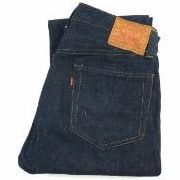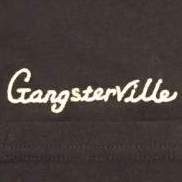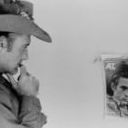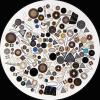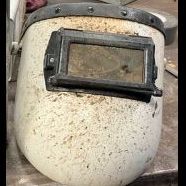Leaderboard
Popular Content
Showing content with the highest reputation on 03/29/25 in Posts
-
17 points
-
15 points
-
15 points
-
14 points
-
I didn’t necessarily want to start a new thread for this but I did anyway as it may have some interest . Obviously repros have been around for a long time now and, I think, some items can be considered vintage in their own right. What old repro-style item you have? I’m thinking primarily jeans, jackets, shirts here, but perhaps there are other items of interest - and I know that some early models were not strict repros. Vintage is slightly subjective and we may all have different views but my thinking (for this thread) is anything prior to 2000. I don’t want to be too exclusive though so anything on the cusp is welcome! My oldest item is this pair of Levi’s Japan 503 BSXX natural indigo from August ‘91 - almost 34 years old!10 points
-
9 points
-
A miniature and very cheap (around 1 USD) coffee filter. I bought it during recent trip to Vietnam. It’s used everywhere there. I also discovered the world of Vietnamese coffee, learning that Vietnam is one of the main coffee exporters in the world. The most popular coffee there is robusta. But my favorite coffee at the moment is luwak.8 points
-
7 points
-
1947 Bluebell's Wrangler 1st prototype with levis style arc and leather label. Around the following year after a lawsuit from Levi's regarding arcs, the W stitching appears and the leather label was replaced by a plastic one. The latter was more to do with the modern washing machine becoming the norm and would shrink the labels right up and they would turn to a piece of unreadable jerky leather. Anyway the reason l'm posting is that this is the clearest original 1st label on a pair l've seen so far, so thought l'd share for posterity sake etc (click twice for clarity). Looks to have been soaked/washed once? Never given Wrangler too much thought when it comes to the 'big 3' but the more l study l realise that they were in many ways the first designer jeans compared to Levi's and Lee. Yes the Wrangler brand was late to the party in terms of the (cowboy) market share, but within a very short space of time apparently took a huge chunk of both its competitor's pie becoming Pro Rodeo sponsors etc etc. Anyway, carry on ..7 points
-
7 points
-
Vintage 1978 - 83 Nike Single Stitch Baseball Shirt I know we all like to wax lyrical about MiJ loopwheeled tees, they are nice, i wear them myself but old single stitch tees are something else.. the material is thin and stretchy giving it a unique drape and softness which you just don't get with heavier gsm..5 points
-
5 points
-
5 points
-
4 points
-
4 points
-
4 points
-
3 points
-
My wardrobe is probably 70% repro, 20% vintage and 10% new but out of that 70%.. i would say 90% of which would now be considered vintage in it's own right. I'm not saying repros peaked in the 90s but i am a bit disalusioned with how relentless the repro game has become, i'd like the SC Collectables but i'm fooling myself if i think this will be it, we all know something else will be just around the corner.. it's just a never ending persuit3 points
-
3 points
-
Good topic. I don’t have exact dates for either of my pairs of MP-series Cane’s, but they’d be somewhere in the mid-‘80s to ‘92 range, and both seem like pretty thorough repros. Always on the hunt for more—my dream pair would be an appropriately sized MP-597 or MP-603.3 points
-
@Maynard Friedman l have a pair of Bartack 1950s MIJ repros from 1994 (l think but could be '92?) - unfortunately no photo as they are over at Mrs_Heech's place in Saaff London. Think the first repros were late 80s?3 points
-
3 points
-
A brand with once coveted appeal has unfortunately pulled off a complete 180. Sinking too quickly in their own poor choices has created circumstances I assume to have been unforeseen. What was never a luxury brand, attempted a luxury brand route while trying to hold onto past protocols. Getting away with collections comprising of 20% appealing designs and 80% non-appealing is usually accomplished through end of season sales (70%+ off). Yet here we are today, not only the current SS25 (which didn’t even appeal to retailers) but as well FW24, SS24, FW23, SS23, FW22, SS22 and FW21 collections sitting on MS with most if not all items in full stock. Full stock we know well will not go on sale. Designs have gone from desirable to laughable. Prices have gone from while not all that reasonable to absolutely ludicrous. Last but not least, material choices have abandoned what was once the core strength and identity of the brand to cheap undesirable alternatives. J70-BU being the only exception imo. Moving forward what would be the best course of action for ACRNMs survival? Offloading MS stock at warehouse sale prices? Reverting back to what they know works (2012-2017) vs. taking risks only luxury brands can afford to take? What’s your opinion and where do you think the brand is headed? Is E going to sink with his ship as captain or take an EscapePodǽ back to safety..3 points
-
3 points
-
3 points
-
3 points
-
First time outside with the newest addition to the family. Rototo / Engineered Garments / YM Factory / Sugar Cane / Hoka3 points
-
3 points
-
I feel like enough people probably have pairs from Rockets now and that there is enough chatter about them in the Unknown Japanese Brands thread that they can get their own thread. There is also limited information on the brand that I could easily find, so it would be nice to have it documented as best as possible here. Most of the information below comes from their website and some chatting with Kato-san. Rockets have been around since 1994 (which is actually longer than Warehouse, the last of the Osaka 5) and were founded by Yasunobu Kato. However, it's unclear to me if they have been producing denim since the beginning. They've historically offered a 1937 cut (0003xx model) a WW2 cut (this s0001xx model), a 1947 (0002xx model), and a 1966 cut (SB-100). Kato-san can also customize a pair for you to cover some of the transitional early war models. WW2 models are offered with either olive HBT or chambray pocket bags. There are also several models of WW2 era jackets with various details, including with and without pocket flaps, although I do not know much about these since the sleeves are too short for me. The primary claim to fame and specialty of Rockets has been their WW2 models and their denim which is known for its heavy lap fades and whiskers. The phrase "Tiger Moustache" on their patches refers to the way in which these whiskers resemble those on a tiger. Kato-san has spent years analyzing vintage fabric from the era to best replicate it, matching the yarn count of the era. It's unclear where the denim is milled. According to the owner Kato-san, the yarns used in the denim have been dyed more than 12 times, so the denim is very dark and will be slow to fade compared to Warehouse or new Denime. After a wash, the denim is a very dark blue that is almost grey/black in appearance with a gritty and coarse handfeel. It creases easily and quickly gets some electric blue highlights, so I can see how these jeans get such pronounced whiskering. In talking with Kato-san, the 1937 model uses the same denim as the WW2 models sold by Rockets. I'm not sure about the 1947 model (although I would guess that it's also the same) and I'm very unclear what is used for the 1966 model (not sure if I've even seen a photo of a pair). Four types of cotton thread are used to sew the garments: No. 30, No. 20, No. 8, and No. 6. The waist is seen with thick No. 6 and No. 8 threads, while the selvedge is sewn with No. 6 thread, consistent with Kato-san's vintage models. The hem is wrapped in four pieces as was typical for vintage pairs prior to the 1960's. Threads are dyed orange and yellow based on estimates for the era. The dyes used on the threads are also selected for low fastness, so they will fade along with the denim. Rockets models also come with a red rayon tab labelled "Venus". The tab is designed to twist significantly after washing. Rockets also owns 3 Union Special sewing machines Rockets have also taken a lot of care to reproduce the style and character of buttons and rivets and buttons of the era. Laurel donut top buttons are used for the WW2 pairs, while iron body buttons are used on the 1937 and 1947 models. WW2 models with chambray pocket bags seem to use iron body buttons for the rest of the fly, while donut buttons are used for the fly of the HBT versions. All buttons are iron and are designed to rust. Front pocket rivets were designed to have a diameter of 10 mm, consistent with vintage rivets. According to the Rockets site, most front rivets used by other brands are 9 mm in diameter. Two types of front rivets are used - copper and iron plated. Hidden rivets are a non-standard shape to capture the shape of those seen on War models. Rockets hand stamps their hidden rivets into the desired shape and then hand engraves them. Rockets offers several versions of their models. There is a standard version where all hardware is new. There is also a "Craft" version, where you can select to use already oxidized hardware. Rockets also offers a "Tailor Made" line of models that are more expensive than their standard "Factory Made" models. Taylor Made models are about 15,000 yen more expensive. The 1937 model seems to be sold as Taylor Made with a claim of being sewn on a vintage machine. I chatted with Kato-san, but I wasn't quite able to learn what this meant in terms of final product, so I just went with a standard model for myself. I will try to add some more details and edit as I have time and learn more. I will also try to locate and cross-post some of the stray pairs found in the WW2 and Unknown Japanese Brands threads here too as I find the time2 points
-
Morning Charlie.. Takahashi-san, (the guy who owns Junky Style) owns a deadstock pair, if you check the blog http://style.junky.co.jp/ There is some info and photos, i posted about them on Pg1 of the M-Series thread, alas, the links were lost in deletiongate but if you pick through the blog posts using the search, i'm sure you can dig it up, the blog is pretty well archived.2 points
-
Got these wide straight Oni's 200ZR back in 2023, made from 21oz secret denim with that special green cast. they already were soft from the start and became softer even more after one or two washes. I wore em through winter almost everyday until now and love the fact that they still evolve beautiful honeycombs though being already washed and super comfy.2 points
-
2 points
-
Hey all. Here are my Warehouse 1101, worn regularly for about 18 months I think. Gotta love how the Banner denim evolves. I began wearing them a little before my eldest son was born in 2017 and discovered a whole new world of knee fades upon his arrival 😌… Jumping forward a few years, I’ve started wearing them again recently so will aim to get better shots of them on here later down the line.2 points
-
My gyro fell apart yesterday and got on my pants, so it was time to give my 50s their second wash. Probably been about 3-4 months since the last one. Lap and thigh fades are really starting to pop.2 points
-
Here's one for the collectors.. ..bonus Lenny photo ..it's a 35yr old deadstock Silverstone 506xx repro from 1990 ..according to 'denim legend'.. Silverstone (and subsequently Ground-Alls) went out of business because of the exacting standards of the perfectionist owners.. i don't know if this is true or denim-lore but they did go bankrupt producing an incredible repro during the golden age / largest denim-boom on the planet ..the very first cowhorn patch which has been oiled annually so it doesn't crack shirt weight denim as we would expect ..you'll not see another one of these this week, month, year.. probably ever2 points
-
1 point
-
I lost an inch in the inseam with the first hot wash and dry of my one wash 47's and it hasn't shrunk at all after that with many more (cold) washes and dryer trips.1 point
-
Vintage / deadstock Nike mesh back.. .. the fat belly swoosh dates from 1978-85, it's printed on a Made in Korea CardinaL.. 'Cardinal Cap & Jacket Co' was established in 1975.. it's clearly got age due to the yellowing of the foam but like we see from a lot of 70s era Nike.. although the company was producing clothing and footwear lines in USA, Japan, Italy, Taiwan, Korea ect.. when it came to event promo, pulling together a couple of 100 caps or tees was done through a third party. Nike tees given away at 10 or 15k road / trail races were printed on Hanes Fifty-Fifty or Russell rather than a Nike label.. I found the Cardinal phone number on a job vacancy for an experienced sewing machine mechanic in an archived page of the Virginia Chronicle so everything tracks.. ..but unlike this one on Grailed, i paid less than £40..1 point
-
I would err on the side of them shrinking beyond the listed measurements since they specifically call out that the denim will shrink with subsequent washes, and they've only washed it once.1 point
-
Some details from the Rockets site are pasted below. All taken from Rockets's site. Thorough dissection of original jeans. Ordering needs to be done by Instagram outside of Japan however (probably only thing that I've used IG for personally). Custom stamped and engraved hidden rivets: Twisted tab Front button Front rivets 1937 model cinch1 point
-
1 point
-
1 point
-
Someone around the forum asked if i'd do a little fit guide for the old SC47s I've had.. and still have numerous pairs of these but they've all been raw.. this was the first o/w pair i've owned, i wouldn't have chosen to buy o/w but they came to me as a part exchange for other denim goodies more than a decade ago and i've only just got around to wearing them. They're tagged 32" ..A lot of SCs have a notoriously nipped waist but if you can get the waist fastened comfortably (post stretch) .. they tend to drape through the legs, if you measure around my waist where my jeans sit, it measures 34" This is after a few weeks of wear / stretch Worn with vintage 1984-87 Nike blue label, Cascade Run Off Tee.. Wonder how long till Freewheelers 'bootleg' this one And a pair of Nike Elite Vntg repros Measurements as follows... The waist has stretched back to raw (or even a few MMs beyond) measurements1 point
-
1 point
-
1 point
-
I've been doing a bit of old school pattern making this week.. I started making a pattern for a valve angle body.. it's going to be cast in WCB grade carbon but because molten metal is weird shit.. i'm making the outside of the pattern in 1/38 contraction (for every 38mm i will add 1mm) to allow for the shrinkage so when the casting cools it will be dimensionally correct at standard.. but the inside of the casting will be made at 1/48 contraction because internal dimensions behave differently to external dimensions even though it's the same material the flanges being thicker tend to contract at 1/38 on the outer face but will contract at 1/60 between the flanges.. it's fkin nuts how liquid metal behaves but i haven't got time to explain metallurgy 101 today.. Started making the core / internal shape.. the wall thickness of the casting needs to be 15mm so all these allowances i'm making need to be made wrong at this stage but absolutely correct when cast.. It's made in halves and doweled together using perfectly round silver steel pegs Dusty Warehouse 506 repro in action ..finish building the former / positive which creates the (negative) internal shape for the liquid to flow through the pump Both halves fit together.. the pink is car body filler, it's easier to create radius's and developments.. ie- the plywood disc is a diameter and the pine is a diameter.. but once the pine has been cut at 45 degrees, it ceases to be a diameter on the angled face, so one needs blending from one shape into the other.. i'm just trying to feel how the liquid would flow through the pump without restricting flow rate.. of creating turbulence at high pressure.. ..half of the core on the joint of half of pattern to double check the wall thicknesses.. this will make more sense on the sketches at the bottom.. The core needs to be very slightly smaller than the print (the print doesn't actually exist, it's just there to support/position the core within the cavity which the pattern will create in the mould) i've allowed 0.25mm around the radius for clearance.. too little and you're in danger of the core not fitting in or not being able to close the mould .. too much and you're 15mm wall thickness will be out of tolerance ..made a few plywood discs, just by drilling a hole through 6x pieces of 1.5mm ply, then using the drill to spin them on the sander.. Set half of the core box former up on a perfectly flat board.. used the discs^ to mount the dowels, build a frame around and cast up in liquid PU resin.. ..once cured, build the other half onto the joint uising the silversteel location pegs.. cast that half too.. once cured, split the mould, and make some levers to gently extract the former.. creating vibration by tapping on the joint with a small hammer will help.. the sand core will just fall out, because it's heavier.. ..lift out the former to leave a perfect resin mould to create the sand core.. ..these are examples of smaller sand cores.. in the foundry, sand is mixed with amine and then blasted into a core box under pressure on a core blowing machine, you can see the line left by the joint line of the corebox brass vents are inserted to allow the air out as the sand/amine mix comes in.. the metal dowel locates both halves of box together to blow the core ..two halves of corebox with a hole in the top to blow sand through ..clipped together with suitcase clips so the sand doesn't blow out of the joint. ..now i have to start mounting the pattern on a male and female joint, to allow the two halves to perfectly locate together in the foundry.. .. then i have to use my metallurgy skills again to create a runner system to allow the metal to flow into the mould.. and feed the casting.. ie- the thick flanges will stay hot longer than the 15mm wall thickness.. but if the 15mm wall cools too quickly, it will contract while the flanges are still liquid which creates small cracks at the point where the 15mm wall meets the flange and the very expensive casting will fail radiography. This is an exothermic sleeve which keeps the metal hot to feed the casting .. so theory is this.. half of the pattern is mounted on a male picture frame joint.. i build the female frame around this platform to ensure a perfect fit for the other half.. i've drawn on part of the runner system with the exothermic sleeve ..a moulding frame is put around the pattern and filled with sand / amine ..the pattern is removed and the sand core drops in.. located by the prints ..the bottom half of sand mould is then dropped on top to close the mould, encasing the core and leaving a cavity / space between the sand moulds and the internal sand core.. ..the whole thing is turned over and metal is cast into the runner system.. filling the cavity with what will become our casting.. when cooled, the sand is broken away, the runner system is cut off with a radiac cutter, the casting then goes to radiography to makes sure it's sound, the flanges are machined up to allow other parts of the pumping system to be cleanly bolted to it .. and off it goes, on it's merry way..1 point
-
speaking of old Fxxx and pioneer v. frontier... from the dark ages and at one point having a pair of both F380 and F350 (which were still the best patterned pair i've worn). was doing a little closet cleaning and found this pair in an old bin... wish i would have had some foresight about 17 years ago and bought about 4 more pairs of these... dig that pocket shape1 point
-
Here are the post-wash measurements and some fit pics for the Rockets (size 32). Roughly a 7.5% shrinkage across the board I’m sure that the front rise and waist will stretch a decent amount Waist: 15.5” Front Rise: 11.5” thigh: 12.5” Leg Opening: 8.7” Inseam: 32.5” I went back and forth between size 31 and 32. Kato-San said that either would work but recommended 32 because the pattern is more balanced. I’m happy with my choice. I like the fit a lot. It feels like there is more room in the crotch than the rise measurement suggests. The denim is also really dark with a coarse hand feel. They should be slow faders. According to Kato-San, the yarn have been dyed deeply with more than 12 dying steps. I’m excited to get some good wear on these starting in 2025. I’ll get some better photos in WAYWT too once the snow clears some and the sky is less grey1 point
-
1 point
-
1 point























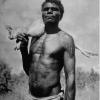


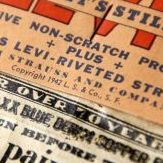


























.thumb.jpeg.a0dada49ca0270b3e8a005a0aed59074.jpeg)
.thumb.jpeg.948d56c655c849dfdf22d6606c0a815a.jpeg)
.thumb.jpeg.6a663e5afe5bc552d44535b9faf1b250.jpeg)
.thumb.jpeg.4c46c4eb9c0064471324264fd110ea43.jpeg)
.thumb.jpeg.5eef38e9da547e6df68a93d67915d54d.jpeg)





































